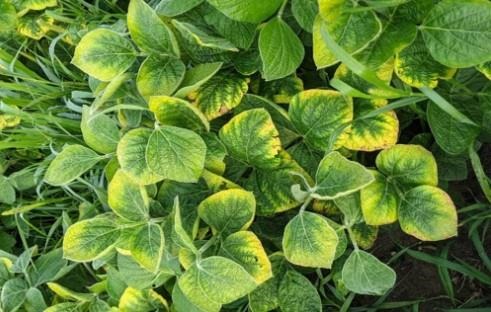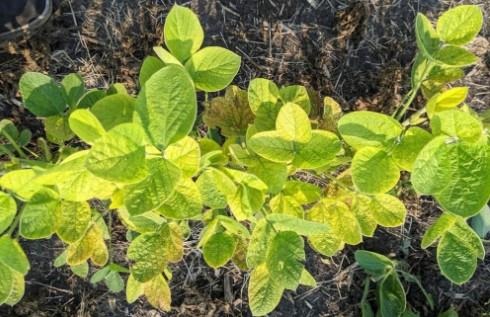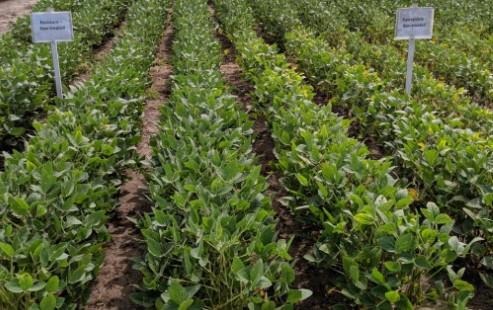By Emmanuel Byamukama
Recently scouted soybean fields were observed with yellowing plants, and one field was found to have plants dying prematurely. Yellowing soybean leaves can be caused by several factors, though most often the first suspect is plant pathogens. Below we provide several factors that may cause soybean plants to yellow at this time in the growing season.
Possible Causes

Figure 1. Soybean plants with potassium deficiency symptoms. Notice the yellowing of leaves along the leaf edges.
POTASSIUM DEFICIENCY
Potassium (K) deficiency symptoms are frequently seen on soybean at early development stages (starting as early as V3) but can also develop on plants throughout the growing season. Potassium deficiency symptoms include yellowing of leaf tissue starting at the leaf tip and moving down the leaf margin (outer edge of leaf) (Figure 1). Severe K deficiency can lead to pre-mature leaf fall of the older leaves. Potassium deficiency is often more severe and shows up in fields with adequate soil test K levels or fertilization in drought years like this year. This occurs because the dry soil conditions slow down root growth and the movement of potassium to plant roots. Additionally, K gets temporarily trapped in some clay types as soils become drier. The best way to alleviate this type of K deficiency is to test your soils for K and fertilize them according to guidelines in SDSU Extension’s Fertilizer Recommendation Guide. These deficiency symptoms often decrease or disappear once adequate precipitation occurs, because root growth will increase along with K movement in the soil to the roots.

Figure 2. Soybean plants with iron deficiency chlorosis. Notice the green veins on yellowed leaves.
IRON DEFICIENCY CHLOROSIS
Iron deficiency chlorosis (IDC) is most common in soils with high pH (usually also poorly drained areas of the field), elevated salts and where there is free lime and elevated levels of nitrates in the soil. Plants with IDC tend to be stunted and yellowing occurs between the leaf veins while veins remain green (interveinal chlorosis). Leaves may also develop brown and necrotic spots in leaf margins. Iron is an immobile nutrient, so these symptoms most often occur first on newer, upper leaves.

Figure 3. A SCN-resistant variety (left side) compared with a susceptible variety (right side). Notice the yellowing in the susceptible variety due to SCN.
SOYBEAN CYST NEMATODE
Soybean cyst nematode (SCN) at high population density in the field can cause soybean plants to be stunted and yellow (Figure 3). The top leaves tend to be affected more than older leaves. Plants likely to be infected are those in low spot areas, field entrances and along the fence line, where SCN is likely to be spread first. At low SCN population density, no obvious symptoms are observed on soybean plants, but still yield loss can occur even at low SCN density in the soil.

Figure 4. Soybean plants killed by lightning injury in recent storms.
LIGHTNING INJURY
Soybeans can be injured by lightning when a heavy storm occurs and there is storm water collecting in portions of the field. Plants injured by lightening tend to be in a circular pattern and have uniform sudden wilting of leaves (Figure 4). Despite being dry for most of this season so far, a few thunderstorms came through recently, and at least one field has been found with lightning injury to the soybeans.
COMMON DISEASES
Common diseases can also cause soybeans to yellow, including: sudden death syndrome, brown stem rot, stem canker and beginning white mold. However, none of these diseases have been found on soybeans so far this season.
Management Considerations
If symptoms being observed are due to a nutrient deficiency, a soil fertility test would be recommended for the future growing season. Tissue sampling can also be done to determine nutrient levels in the plant tissues. Plant tissues for nutrient analysis should be sampled from a good area and the affected area separately and sent to a lab.
The best way to determine if a field has SCN is to soil sample and send the soil to the South Dakota State University (SDSU) Plant Diagnostic Lab for analysis. This test if free of charge (paid for by Soybean Checkoff funds) and the form and address where to send the sample can be found on the lab’s Submission Forms & Guidelines page. SCN can be managed through using resistant varieties and, where high SCN population density is occurring, a combination of resistant varieties and nematicide seed treatments.
Source : sdstate.edu